|
|
|
Sort Order |
|
|
|
Items / Page
|
|
|
|
|
|
|
| Srl | Item |
| 1 |
ID:
096311
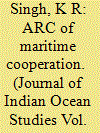

|
|
|
| 2 |
ID:
133482
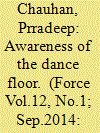

|
|
|
|
|
| Publication |
2014.
|
| Summary/Abstract |
As the world entered the last couple of decades of the 20th century, the sharply differing views and reactions of India and the United States (US) to unfolding global and regional events had brought bilateral relations to almost the nadir of the Nixon years. As James Heitzman and Robert L. Worden, the Washington-based editors of India: A Country Study have recorded (http://www.countrystudies.us/india/134.htm), "In the 1980s the Indian and United States governments had divergent views on a wide range of international issues, including Afghanistan, Cambodia, the Middle East, and Central America. Serious differences also remained over the US policy toward Pakistan and the issue of nuclear proliferation. India was repeatedly incensed in the Eighties when the US provided advanced military technology and other assistance to Pakistan despite the US' concerns about Pakistan's covert nuclear programme. For its part, Washington continued to urge New Delhi to sign the Treaty on the Non-Proliferation of Nuclear Weapons and, after the successful test launch of the Indian Agni intermediate-range ballistic missile in May 1989, called on New Delhi to refrain from developing a ballistic missile capability by adhering to the restrictions of the Missile Technology Control Regime". This unhappy prelude makes the vibrancy of the India-US bilateral defence relationship in general (and the maritime relationship in particular) over the very next decade all the more striking.
|
|
|
|
|
|
|
|
|
|
|
|
|
|
|
|
| 3 |
ID:
091245
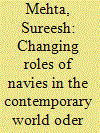

|
|
|
|
|
| Publication |
2009.
|
| Summary/Abstract |
History has taught India two lessons: firstly, that neglect of maritime power led to loss of sovereignty, and secondly, that it takes many decades to restore maritime power after a period of neglect and decline.
|
|
|
|
|
|
|
|
|
|
|
|
|
|
|
|
| 4 |
ID:
095873
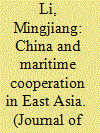

|
|
|
|
|
| Publication |
2010.
|
| Summary/Abstract |
Future international relations in East Asia are likely to be largely shaped by the maritime strategies and policies of various actors. This paper examines China's policy and behavior in maritime cooperation in the East Asian region in recent years, a topic that has been insufficiently understood. I suggest that while it is necessary and useful to take into account China's naval power, more attention to Chinese intentions and policy on East Asian maritime issues is warranted to arrive at a more balanced, and arguably more accurate, understanding of China's role in East Asian maritime affairs. This paper takes stock of China's changing perceptions, attitudes, and behaviors in maritime cooperation in the region. I describe China's new policy moves in the South China Sea and East China Sea. I also address some of the major Chinese concerns for further maritime cooperation in East Asia. I conclude that while a grand cooperative maritime regime is still not possible from a Chinese perspective, China is likely to agree to more extensive and substantive maritime cooperation in many functional areas, most notably in the non-traditional security arena.
|
|
|
|
|
|
|
|
|
|
|
|
|
|
|
|
| 5 |
ID:
171877
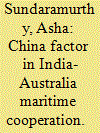

|
|
|
|
|
| Summary/Abstract |
The rise of China in recent decades has forged closer naval bilateral relationships in the Indo-Pacific region. Amongst these the Indo-Australian maritime ties have been a noteworthy development. Beijing's expanding maritime capabilities in the Indian Ocean Region and growing influence in the South China Sea have become a core convergence in Indo-Australian cooperation. China's approach of asserting its rise as friendly while simultaneously becoming more aggressive in boundary claims has increased security concerns for Australia and India, thereby prompting maritime security convergences through the AUSINDEX exercises, increased trilateral engagements and establishing a Quadrilateral Security Dialogue (QSD). However, the maritime convergence is not only based on hedging, as there are common views of maintaining an inclusive security framework with China to address non-traditional maritime security threats affecting the region. In examining the China factor, this article also draws in other players such as USA, Japan and the ASEAN states with stakes involved in the region as also influencing Indo-Australian relations in their considerations of China. This article will explore China as a strong point of interest in India-Australia maritime cooperation; the roots of which can be traced from 1991 and have culminated into synergies of collaboration.
|
|
|
|
|
|
|
|
|
|
|
|
|
|
|
|
| 6 |
ID:
107220
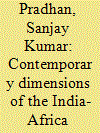

|
|
|
| 7 |
ID:
179587
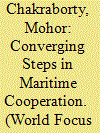

|
|
|
|
|
| Summary/Abstract |
India’s relations with the island-nation of Maldives has been on an upswing particularly since 2018, when President Ibrahim Mohamed Solih assumed office. As the present trends indicate, bilateral relations between New Delhi and Male are expected to take a “quantum jump” as both neighbours are committed to sustaining this positive impulse.
|
|
|
|
|
|
|
|
|
|
|
|
|
|
|
|
| 8 |
ID:
130877
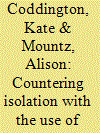

|
|
|
|
|
| Publication |
2014.
|
| Summary/Abstract |
Governments detain asylum seekers on islands across the Indian Ocean region, including Australia's Christmas Island, Papua New Guinea's Manus Island, Nauru, and across the Indonesian archipelago. Scholars and advocates alike have shown that the ambiguous jurisdiction and complex legal migration statuses that emerge in these areas, as well as their remote location and isolation, contribute to their popularity as sites of migrant detention. The negative effects of isolation and remoteness on migrants' physical and mental health, as well as their legal outcomes, have been well documented. We argue, however, that detainees and others are countering the effects of isolation with the use of technology. Ethnographic research conducted on the islands within Australian and Indonesian migrant detention networks suggests that asylum seekers detained in remote sites across the region are combating the isolation of detention with the use of mobile phones, internet access, and social media networks. They communicate with friends, relatives, legal representatives, advocates, activists, and members of the public beyond prison walls to transmit information, facilitate advocacy inside and outside of detention facilities, and construct transnational support networks. In turn, punitive policies to discipline asylum seekers by limiting methods of communication threaten these efforts.
|
|
|
|
|
|
|
|
|
|
|
|
|
|
|
|
| 9 |
ID:
158312
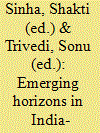

|
|
|
|
|
| Publication |
New Delhi, Pentagon Press, 2018.
|
| Description |
xxix, 233p.: tables, maps, figureshbk
|
| Standard Number |
9789386618375
|
|
|
|
|
|
|
|
|
|
|
|
Copies: C:1/I:0,R:0,Q:0
Circulation
| Accession# | Call# | Current Location | Status | Policy | Location |
| 059361 | 327.540597/SIN 059361 | Main | On Shelf | General | |
|
|
|
|
| 10 |
ID:
019325
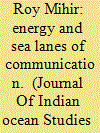

|
|
|
|
|
| Publication |
April 2001.
|
| Description |
55-66
|
|
|
|
|
|
|
|
|
|
|
|
|
|
|
|
| 11 |
ID:
130875


|
|
|
|
|
| Publication |
2014.
|
| Summary/Abstract |
The fisheries statistics systems of many countries are performing poorly, often failing to report on small-scale catches, particularly from subsistence and recreational fisheries. These deficiencies, which lead to the underestimation of catches, are particularly evident in overseas territories of developed countries. This study is an attempt to remedy this for the years 1950-2010 for the Australia Indian Ocean Territories, an area from which little reporting is done. The results suggest that the Cocos (Keeling) Islands had a catch of approximately 80 t·year?1 in the 1950s (essentially subsistence based), which increased, starting in the mid-1980s to reach 250 t·year?1 in recent years, mainly due to the introduction of recreational and later commercial fishing, with signs of overexploitation since 2000. The coastal catch from Christmas Island was tentatively assessed as being higher (40-70 t·year?1) in the 1950s and 1960s than in the 2000s (<30 t·year?1). Fisheries managers in these areas should focus on determining primary target species and their vulnerability to overfishing, as well as developing island specific recreational fishing management plans.
|
|
|
|
|
|
|
|
|
|
|
|
|
|
|
|
| 12 |
ID:
130873
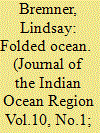

|
|
|
|
|
| Publication |
2014.
|
| Summary/Abstract |
This paper presents experimental research on the Indian Ocean being undertaken within the context of what has been termed architecture's contemporary geographic turn. It investigates how oceanic practices and protocols fold into spatial and architectural products on land, figuring both sea- and land-based logics. It frames this ocean through three tropes: as contact zone, with which are associated ideas of creolisation, transnationalism, entanglement, compaction and multi-polarity; as circulator with which are associated ideas of connectivity, passage, lane, route, choke point, network, port, dock and deposit; and as ecology, with which are associated ideas of liquidity, cycle, rhythm and climate change. The paper introduces these tropes and investigates sites brought into focus through them, highlighting the wider global dynamics or processes they reveal. It concludes with provisional thoughts about what these amphibious sites offer for understandings of architecture and urbanism in today's hyper-articulated, globalised world.
|
|
|
|
|
|
|
|
|
|
|
|
|
|
|
|
| 13 |
ID:
130752
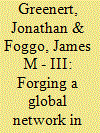

|
|
|
|
|
| Publication |
2014.
|
| Summary/Abstract |
As the world becomes more complex and the oceans less secure, we are compelled to strengthen the bonds of international maritime cooperation.
The United States of America maintains the largest maritime force in the world. The U.S. Navy is uniquely postured to operate forward and be ready to respond to any threat globally. This enables us to have naval forces present where it matters and when it matters. Throughout history, however, we have learned that it is almost always in the best interest of nations to act together when responding to crises, whether it involves deterrence or combat or providing humanitarian support. Accordingly, the U.S. Navy has rarely operated alone in a crisis. One of our advantages, as a nation and as a Navy, has been our extensive network of alliances, partnerships, and coalitions.
|
|
|
|
|
|
|
|
|
|
|
|
|
|
|
|
| 14 |
ID:
104452
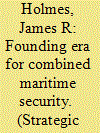

|
|
|
|
|
| Publication |
2011.
|
| Summary/Abstract |
In a nutshell the article posits that American naval power, and thus the United States' ability to police the seas, will continue to decline, and that Washington is attempting to compensate by fashioning a new paradigm of multinational maritime security. With no likely candidate for a global navy in the offing the challenge is to create one or more multinational guarantors of free navigation. I attempt to gaze into the future, discerning the likely dynamics of this coalition-building project.
|
|
|
|
|
|
|
|
|
|
|
|
|
|
|
|
| 15 |
ID:
113261
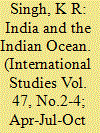

|
|
|
|
|
| Publication |
2010.
|
| Summary/Abstract |
India has not had a policy specific to the Indian Ocean beyond the knee-jerk and ad hoc responses to the changing regional and global environment. The Indian Navy, however, played a significant part in formulating the maritime perspective vis-à-vis the Indian Ocean and in dovetailing it with the country's larger foreign policy objectives in the region. Owing to ill-advised responses to interventions from both within and outside the region, India faced near isolation in the Indian Ocean region during the second half of the Cold War era. India's sensitivity to new opportunities and concerns about emerging threats to the stability of the region have brought about a change in India's relationships after the end of the Cold War. At present, India's policy seems to be motivated by priorities such as energy security, war on terror and maritime security. As a major regional power and enjoying greater credibility than during the Cold War era, India should act as a facilitator to build structures of maritime cooperation in the Indian Ocean region that can help integrate the littoral states and thus pave the way for a firmer foundation for a future peace zone in the Indian Ocean.
|
|
|
|
|
|
|
|
|
|
|
|
|
|
|
|
| 16 |
ID:
053338
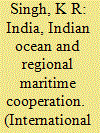

|
|
|
|
|
| Publication |
Apr-Jun 2004.
|
|
|
|
|
|
|
|
|
|
|
|
|
|
|
|
| 17 |
ID:
118124
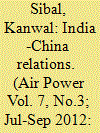

|
|
|
| 18 |
ID:
137764
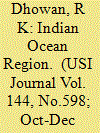

|
|
|
| 19 |
ID:
074986
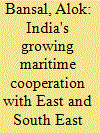

|
|
|
| 20 |
ID:
143836
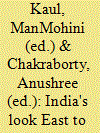

|
|
|
|
|
| Publication |
New Delhi, Pentagon Press, 2016.
|
| Description |
xxvii, 300p.hbk
|
| Standard Number |
9788182748477
|
|
|
|
|
|
|
|
|
|
|
|
Copies: C:1/I:0,R:0,Q:0
Circulation
| Accession# | Call# | Current Location | Status | Policy | Location |
| 058479 | 327.540468/KAU 058479 | Main | On Shelf | General | |
|
|
|
|
|
|
|
|
|